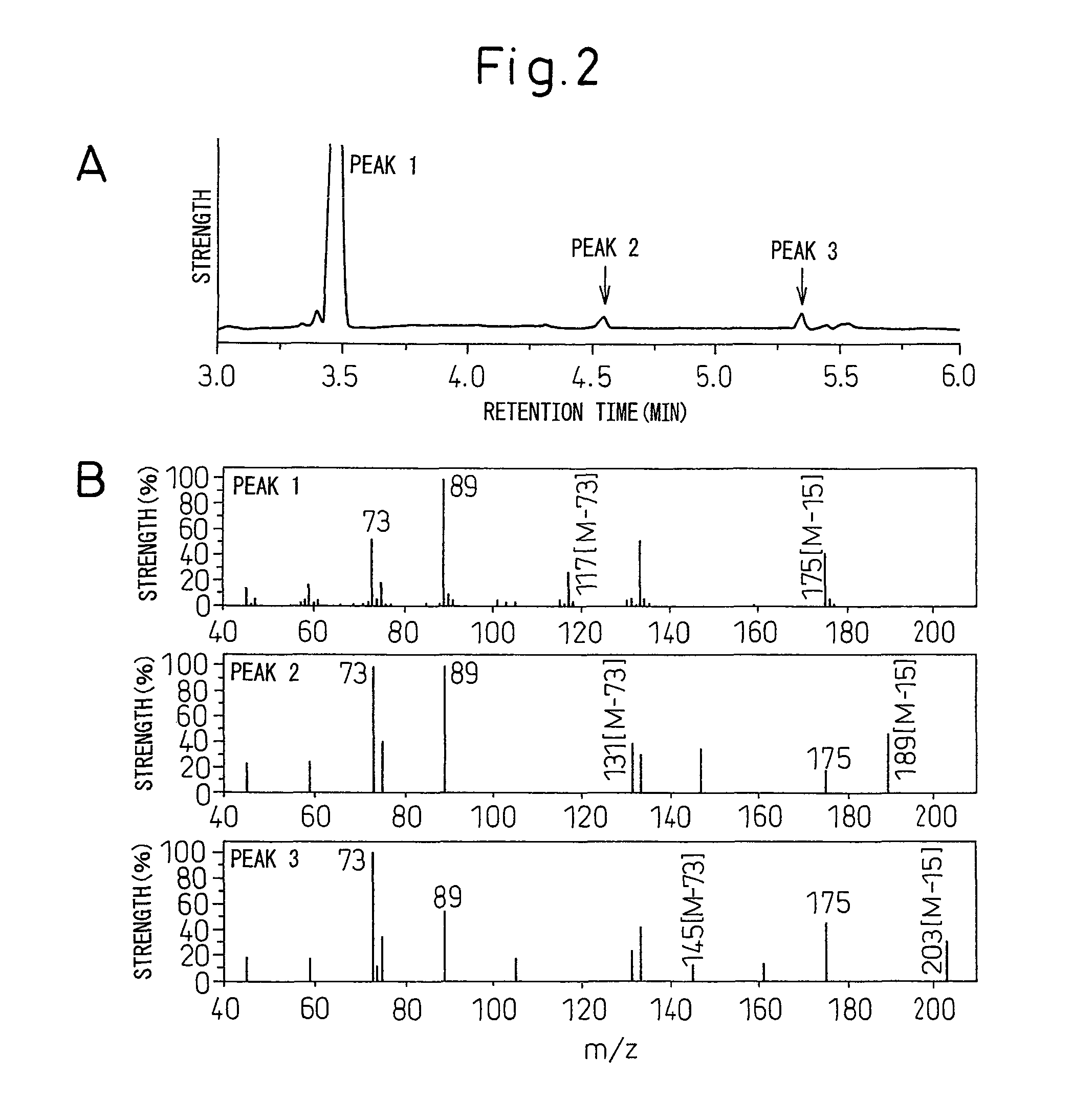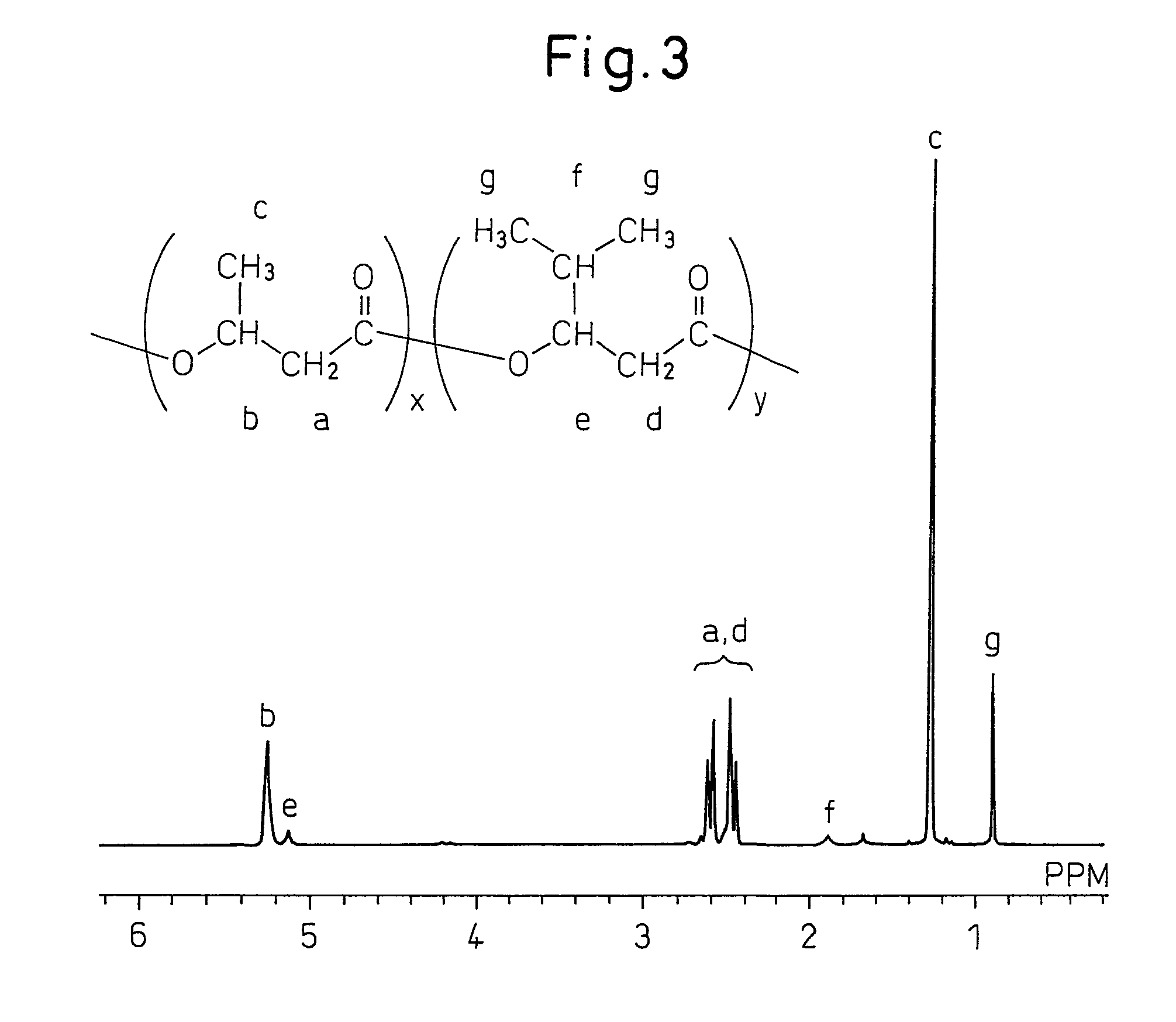Polyhydroxyalkanoic acid copolymer and process for preparing same
a technology of polyhydroxyalkanoic acid and copolymer, which is applied in the field of polyhydroxyalkanoic acid copolymer and a method of preparing it, can solve the problems of high crystallization and lack of flexibility, and difficult synthesis of polymers in terms, and achieves strong and flexible flexibility, easy processing to films, and low cost. the effect of efficiency
- Summary
- Abstract
- Description
- Claims
- Application Information
AI Technical Summary
Benefits of technology
Problems solved by technology
Method used
Image
Examples
examples
[0062]The present invention will now be explained in detail with reference to examples, but it should be noted that the present invention is not limited to them in any way.
Materials and Preparation Methods
(1) Microorganisms
[0063](a) Escherichia coli Strain S17-1 (Obtained from H. G. Schlegel (Georg-August-Universitat, Germany))
[0064](b) Ralstonia eutropha PHB−4 (DSM541, a PHA-Accumulation Potential-Deficient Strain of Ralstonia eutropha H16, Obtained from DSM of Germany)
(2) Medium
[0065](a) Luria-Bertani (LB) Medium
[0066]Ten g of Bacto trypton, 5 g of yeast extract and 10 g of NaCl were dissolved in 1 L of deionized water, and autoclaved at 121° C. for 20 minutes, to prepare a liquid medium. The agar medium was prepared by adding agar to the above components to 1.5-2% (wt / vol) followed by autoclaving. An antibiotic (kanamycin: the final concentration 50 μg / mL) was added to both the liquid medium and the agar medium after autoclaving.
[0067](b) Nutrient-Rich (NR) Medium (pH 7.0)
[0068]T...
working examples 1 and 2
Production of P(3HB-co-3H4MV) Using a Polymerizing Enzyme Derived from Pseudomonas sp. Strain 61-3
(1) Construction of a Transformant Ralstonia Eutropha Strain PHB−4
[0124]The competent cells of E. coli strain 17-1 were obtained by treating the cells in the logarithmic growth phase with a calcium chloride solution. To the cells, the DNA of plasmid pBBR1″ClPsABRe, was added, and its introduction into the cells was promoted by heat shock of a temperature rise to 42° C.
[0125]Conjugation was conducted in order to introduce the gene into Ralstonia eutropha strain PHB−4. E. coli strain 17-1 having plasmid pBBR1″ClPsABRe introduced therein was inoculated to 1.7 mL of the LB medium, and cultured under shaking at 37° C. for 15 hours. Also, the host (Ralstonia eutropha strain PHB−4) to which the gene is to be introduced was inoculated to 1.7 mL of the NR medium, and cultured at 30° C. for 15 hours. After culturing was completed, each of the total amount of the culture liquid was transferred to ...
working examples 3 to 6
Production of P(3HB-co-3H4MV) from Fructose and 4-Methylvaleric Acid by a Ralstonia eutropha Strain Having an Aeromonas caviae-Derived Polymerizing Enzyme Introduced Therein
[0134]In a manner similar to Working Example 2 except that plasmid pBBREE32d13 was used in stead of plasmid pBBR1″ClPsABRe, it was investigated whether the gene of polyhydroxyalkanoic acid-polymerizing enzyme derived from Aeromonas caviae can incorporate 3H4MV. Also, a mutant (NSDG mutant) in which asparagine at position 149 of the polyhydroxyalkanoic acid-polymerizing enzyme derived from Aeromonas caviae was replaced with serine and aspartic acid at position 171 was replaced with glycine, was prepared according to the method described in FEMS Microbiol Lett, 277 (2007), pp. 217-222 in order to investigate whether the gene of the polymerizing enzyme encoding said mutant can incorporate 3H4MV. The results are shown in Table 3.
[0135]
TABLE 3The biosynthesis of PHA from fructose and 4-methylvalericacid by a Ralstonia...
PUM
| Property | Measurement | Unit |
|---|---|---|
| mol % | aaaaa | aaaaa |
| mol % | aaaaa | aaaaa |
| temperature | aaaaa | aaaaa |
Abstract
Description
Claims
Application Information
 Login to View More
Login to View More - R&D
- Intellectual Property
- Life Sciences
- Materials
- Tech Scout
- Unparalleled Data Quality
- Higher Quality Content
- 60% Fewer Hallucinations
Browse by: Latest US Patents, China's latest patents, Technical Efficacy Thesaurus, Application Domain, Technology Topic, Popular Technical Reports.
© 2025 PatSnap. All rights reserved.Legal|Privacy policy|Modern Slavery Act Transparency Statement|Sitemap|About US| Contact US: help@patsnap.com



